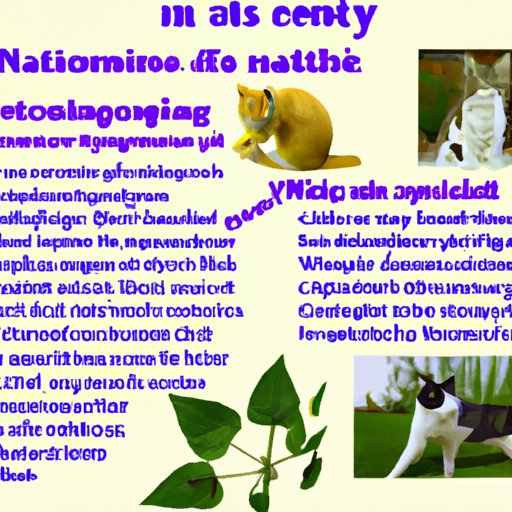Introduction
Catnip is a popular treat among felines that has been used since ancient times. It is well-known for its ability to cause cats to become unusually excited and playful, but how does it work? This article will explore the science behind catnip and its effects on cats, as well as potential risks associated with its use.
Exploring the Science Behind Catnip: How Does it Work?
To understand how catnip works, it’s important to first understand what it is. Catnip (Nepeta cataria) is a member of the mint family and is native to Europe, Asia, and Africa. It grows in the form of a shrub and produces fragrant leaves that contain an oil called nepetalactone. This oil is the active ingredient in catnip that gives it its unique properties.
When cats come into contact with catnip, they become excited and playful. This reaction is due to nepetalactone, which acts as a stimulant when inhaled or ingested by cats. It binds to receptors in their noses and triggers a response in their brains that causes them to become temporarily intoxicated.
The biological basis for this response is complex. Cats have specific receptor proteins in their noses that are sensitive to the chemical compounds found in catnip. When these proteins bind to the compounds, it triggers a response in the brain that produces the “high” cats experience from catnip.
An In-Depth Look at Catnip and Its Effects on Cats
When cats come into contact with catnip, they may exhibit a wide range of behaviors. These behaviors can include rolling around, rubbing their faces against the plant, meowing loudly, drooling, and leaping around. The effects usually last between five and thirty minutes before wearing off.
In addition to causing cats to become excited and playful, catnip may also have other beneficial effects. Studies have shown that it may have calming effects on cats, reduce stress levels, and even act as an insect repellent.
Is Catnip Safe for Your Feline Friend?
Though catnip is generally safe for cats, there are some safety concerns that pet owners should be aware of. Catnip is a mild hallucinogen, and some cats may become overly aggressive or hyperactive when exposed to it. Therefore, it is important to monitor your cat’s behavior when giving them catnip and to discontinue use if any negative side effects occur.
Cats can also easily overdose on catnip if given too much, so it is important to only give small amounts at a time. Symptoms of an overdose include vomiting, diarrhea, and excessive drooling.
The Fascinating History of Catnip and Its Impact on Cats
Catnip has been used for centuries to treat a variety of ailments in humans, including headaches, colds, and digestive problems. It was also used as a sedative and pain reliever. In ancient Egypt, it was even used as a substitute for opium.
Today, catnip is most commonly used as a treat for cats. It is widely available in pet stores and online, and many cats find it irresistible. Catnip toys are particularly popular, and they provide cats with mental stimulation and a way to express their natural hunting instincts.
Conclusion
Catnip is a popular treat for cats that has a wide range of effects. It is made up of nepetalactone, an oil that binds to receptors in cats’ noses and triggers a response in their brains. While catnip is generally considered safe for cats, it is important to monitor your cat’s behavior when using it and to avoid giving them too much. Catnip has a long history of being used as a medicinal herb and is still enjoyed by cats today.
(Note: Is this article not meeting your expectations? Do you have knowledge or insights to share? Unlock new opportunities and expand your reach by joining our authors team. Click Registration to join us and share your expertise with our readers.)
